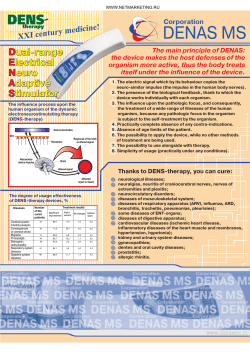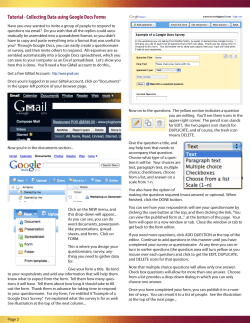
Document 265264
430 Nahant Rd., Nahant, MA, USA 01908 www.northeastern.edu/marinescience/ogl ⋅ 781-581-7370 ⋅ oglinfo@neu.edu Sample Preparation and Submission Protocol For CHAOS fixative Sampling overview: 1) OGL’s priority is to preserve specimens from a broad range of species. 2) If time and resources permit, up to 5 individuals of the same species can be collected and archived. 3) Tissue samples can be preserved, stored, and shipped to OGL at room temperature in CHAOS or immediately frozen and shipped on dry ice. 4) Please document specimens with voucher material (e.g. diagnostic parts or whole organism deposited in a traditional museum) and/or digital images. Instructions for sample preparation: Our goals are to preserve the DNA contained in the tissue samples and to minimize/eliminate sample contamination with non-source DNA (e.g. your DNA from handling tissues or DNA from other organisms that might come into contact with the sample tissue). In general, wear clean gloves and use clean tools/surfaces when sampling. 1) Clean the specimen: ideally using filtered seawater. 2) Document the specimen: If possible, preserve voucher materials such as hard parts or whole organisms (for details see “OGL Datasheet and Vouchers” on the following pages). Photograph the intact organism and record the image number/name on the provided Excel datasheet 3) Place the tissue in the sample tube provided and fill with ONLY enough CHAOS solution to cover the tissue. (The tissue and DNA contained therein will go into solution. The more liquid CHAOS you add, the less concentrated the DNA sample will be.) 4) Storage and shipping: Samples can be stored and shipped at room temperature. PLEASE CONTACT OGL PRIOR TO SHIPPING ANY MATERIAL. 5) Data: OGL provides an Excel spreadsheet to record sample data. PLEASE FILL OUT THE MASTER AND PARTICIPANT INFO WORKSHEET TABS. You can ignore any others. The top row is provided as an example entry with data already filled in. If information is not applicable or not determined, please enter NA or ND, accordingly, in the corresponding field. Field definitions are included in the “Definitions” tab. 6) Please email us the completed sample spreadsheet and the signed Deposit Form prior to shipping the samples. If there are digital vouchers, please send us the signed Image Deposit Form as well. Note: CHAOS can be shipped or transported without any hazardous designation. It contains ingredients that are “irritants” to the skin, eyes, and respiratory system and may be harmful if ingested; therefore always wear gloves when handling. Use in a well-ventilated area. Because local regulations governing chemical disposal vary widely, please return any remaining fixative to OGL with the samples for proper disposal. 1 OGL Datasheet and Vouchers: OGL provides each depositor with an Excel spreadsheet (LastName_L000xx.xls) for documenting samples deposited at OGL. Provide as much data as you can for each sample- more documentation makes samples that much more useful to other researchers. Definitions 1) Required fields: Fields marked with an asterisk (*) are required for submission. All other fields are optional. However, please fill in blank cells with NA (not applicable) or ND (not determined) as appropriate. Cells shaded gray are for OGL internal use only. These and all headers are uneditable. 2) Data Example: The grayed-out row 5 of the Excel spreadsheet provides an example of appropriate data entry. 3) Lot, Participant, and Project IDs: OGL will assign these numbers to you and fill them in on the spreadsheet before sending it. Unless you choose to specify someone else, the project leader will also be the depositor. 4) Specimen: We define a specimen as a single individual organism. Each organism is assigned a unique organism number. Please number the unique individual specimens, starting with 1, in column B of the Excel spreadsheet. 5) Taxonomy: We provide fields for genus and species. Please include the finest level of classification that you can with reasonable certainty. IT IS BETTER TO LEAVE INCOMPLETE FIELDS THAN TO GUESS. The Organism Notes field can be used to add additional taxonomic levels (e.g. subspecies, subfamily, etc.) or to explain taxonomic uncertainty. You may also express uncertainty in the ID Qualifier field. We provide the sp., aff., and cf. to express uncertainty and apply these terms in a somewhat unconventional and simplified form as described below. a) sp. - We use sp. with no species epithet (e.g. Solemya sp.) to indicate that the specimen likely belongs to the given genus but we cannot confidently assign it to a species. b) cf. - We use cf. (Latin for confer = compares with) with a species epithet (eg. Solemya cf. velum) to indicate that the specimen likely belongs to the named genus and species but there is doubt and further analysis should be done. c) aff. - We use aff. (Latin for affinis = related to) with a species epithet when the biological species is probably not the named species but appears to be closely related to it. (eg: Solemya aff. velum, means a distinct species of Solemya which is similar or has affinity with S. velum but is PROBABLY NOT S. velum. 6) Sample: A sample is any part or derivative of an organism (i.e. an aliquot of blood, piece of tissue, or a DNA extract). For very small organisms, a sample may consist of a whole intact organism. Each Sample is assigned a unique tube number. The tube numbers are printed on the provided labels and on the Excel spreadsheet. On the spreadsheet MAKE SURE EACH 2 TUBE NUMBER HAS AN ASSOCIATED ORGANISM NUMBER. Note that samples obtained from the same individual organism will have the SAME Organism Number. 7) Sample tissue source: A tissue source is a description of the type of tissue from which the sample derives. This may be specific (e.g. dorsal half of anterior adductor muscle), or as general (e.g. blood, muscle, integument, gonad, unidentified visceral organ, etc.) as accuracy, judgment and certainty allow. 8) Collection Location: We provide fields for a great deal of location information. You may not have information to fill all location fields, and some fields may simply not apply to your specimens. Please provide as much information as possible within the constraints of certainty and judgment. We prefer missing information to inaccurate information. THE MOST IMPORTANT TYPES OF LOCATION INFORMATION ARE GIS COORDINATES, DEPTH, AND ACCURACY. If you do not have precise GIS coordinates (in decimal degrees, e.g., 47.2312) taken at the collection site, it may be possible to estimate using websites such as Google Earth or ACME mapper to locate the collection site using nearby landmarks as a guide. Be sure to indicate the accuracy of your coordinates estimated in meters. For example, you may know that you have collected within 1000 meters of a known landmark (e.g. a public pier or named beach. In this case, include the coordinates of the landmark and record 1000m as the accuracy. 9) Collection Event: We define a collection event as the discrete act of obtaining the specimen. This might be a dive on SCUBA or submersible vehicle; deployment of a trap, trawl, or fishing gear; or simply a visit to a tide pool. In most cases this event will have a single discrete date but may have a range of dates in some cases (e.g. when a trawl or trap is deployed for multiple days). 10) Vouchers: We define a voucher as a specimen (or sample containing diagnostic parts of a specimen) set aside to serve as a morphological reference for the remaining experimental samples and extracts. When possible, the voucher materials should be derived from the same specimen as the experimental samples and extracts. In the case of very small specimens, the voucher may be one or more individuals from the same collection that have been determined by morphology or DNA evidence to belong to the same species as the experimental specimen. A voucher is only valid if it is submitted to a publicly accessible collection and the institution name and accession number is reported on the OGL Excel spreadsheet. If you cannot find an appropriate collection in which to your voucher materials, contact OGL for assistance. In addition to traditional morphological vouchers OGL also accepts: a) eVouchers: Any form of electronic data file that is used as an alternative or supplement to morphological vouchers. These may include digital images, x-ray images, sound files, etc. b) mVouchers: Any molecular sequence that is used as an alternative or supplement to morphological vouchers. May include mitochondrial Cytochrome Oxidase I sequences (DNA barcodes) or other standard molecular biomarkers, e.g. small- or large-subunit ribosomal RNA genes. PLEASE LIST ALL AVAILABLE VOUCHERS FOR EACH SPECIMEN AND PROVIDE IMAGES, IF POSSIBLE. 3 11) Permits: Please provide copies of permits required for sampling, transferring, and, if applicable, importing/exporting material. These permit numbers should be included on the spreadsheet to provide governance guiding future use of the material. 12) Participant Info: Please fill in contact information for all participants (depositor, collectors, identifiers) listed on the “Master” worksheet on the secondary worksheet entitled “Participant Info.” You can navigate to this worksheet by clicking the lower right workbook tab. 4
© Copyright 2025










